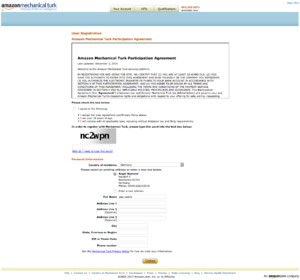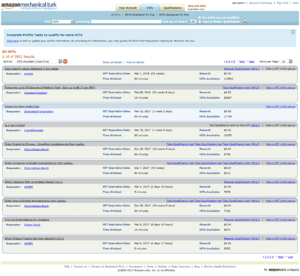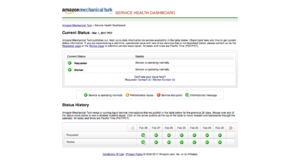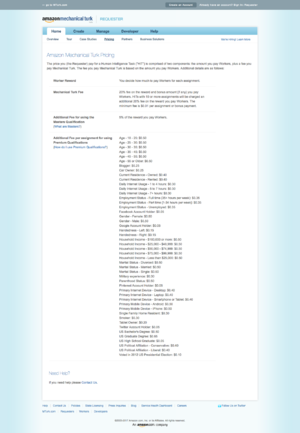Difference between revisions of "Amazon Mechanical Turk"
| Line 29: | Line 29: | ||
== <small>'''Description'''</small> == | == <small>'''Description'''</small> == | ||
| − | Amazon Mechanical Turk | + | Amazon Mechanical Turk is a digital job marketplace in the form of a crowdsourcing |
| + | platform. It was conceived by Venky Harinarayan for Amazon and publicly launched in | ||
| + | November 2005. Mechanical Turk uses an API to establish a relationship between | ||
| + | individuals or companies posting offers (called “requesters” or applicants) and workers | ||
| + | (“providers” or, simply, “turkers”), charged with performing a requested job in exchange for a | ||
| + | sum of money set by the requesters, for which Mechanical Turk charges a percentage | ||
| + | commission. The nature of these jobs, also called tasks, offered by Mechanical Turk, can be | ||
| + | considered as micro-jobs, meaning, a series of repetitive and unrelated tasks that overall | ||
| + | make up a larger project, the rewards for which range from a few cents to a dollar, | ||
| + | depending on the complexity and the time required to finish. As suggested by Amazon’s own | ||
| + | definition, these tasks are oriented to solving problems which can’t be solved successfully | ||
| + | with existing algorithms, requiring a kind of “human intelligence”: translating a small portion | ||
| + | of text, tagging images, transcribing audio, searching images and information for certain | ||
| + | products, data cleansing, etc. Thus, work logic based on Human Intelligence Tasks (HIT) is | ||
| + | considered “Artificial, Artificial Intelligence” (Celebrating 11 Years of Artificial, Artificial | ||
| + | Intelligence). The project’s name itself, Mechanical Turk, is a reference to human workers | ||
| + | simulating algorithmic tasks named after The Turk, an automaton created by Wolfgang Von | ||
| + | Kempelen in 1769, simulating a chess player that in reality was being manipulated by a | ||
| + | person hidden inside, controlling its movements. | ||
| − | Amazon Mechanical Turk | + | |
| + | Amazon Mechanical Turk requires its requesters to have a billing address in the US, | ||
| + | Canada, UK or Australia. Workers, or “turkers”, can be paid by bank transfer if they live in | ||
| + | the US or India, or via Amazon gift cards if they’re in any other country | ||
| + | (https://www.mturk.com/mturk/help?helpPage=worker#how_paid). Hence, worker | ||
| + | demographics are mainly split among the US (around 80%) and India (roughly the remaining | ||
| + | 20%). | ||
== <small>'''Bibliography'''</small> == | == <small>'''Bibliography'''</small> == | ||
Latest revision as of 21:14, 15 May 2017
Self-portrait
Amazon Mechanical Turk is a marketplace for work that requires human intelligence. The Mechanical Turk service gives businesses access to a diverse, on-demand, scalable workforce and gives Workers a selection of thousands of tasks to complete whenever it's convenient.
Amazon Mechanical Turk is based on the idea that there are still many things that human beings can do much more effectively than computers, such as identifying objects in a photo or video, performing data de-duplication, transcribing audio recordings, or researching data details. Traditionally, tasks like this have been accomplished by hiring a large temporary workforce (which is time consuming, expensive, and difficult to scale) or have gone undone.
A Human Intelligence Task, or HIT, is a question that needs an answer. A HIT represents a single, self-contained task that a Worker can work on, submit an answer, and collect a reward for completing. (https://www.mturk.com/mturk/help?helpPage=overview)
Description
Amazon Mechanical Turk is a digital job marketplace in the form of a crowdsourcing platform. It was conceived by Venky Harinarayan for Amazon and publicly launched in November 2005. Mechanical Turk uses an API to establish a relationship between individuals or companies posting offers (called “requesters” or applicants) and workers (“providers” or, simply, “turkers”), charged with performing a requested job in exchange for a sum of money set by the requesters, for which Mechanical Turk charges a percentage commission. The nature of these jobs, also called tasks, offered by Mechanical Turk, can be considered as micro-jobs, meaning, a series of repetitive and unrelated tasks that overall make up a larger project, the rewards for which range from a few cents to a dollar, depending on the complexity and the time required to finish. As suggested by Amazon’s own definition, these tasks are oriented to solving problems which can’t be solved successfully with existing algorithms, requiring a kind of “human intelligence”: translating a small portion of text, tagging images, transcribing audio, searching images and information for certain products, data cleansing, etc. Thus, work logic based on Human Intelligence Tasks (HIT) is considered “Artificial, Artificial Intelligence” (Celebrating 11 Years of Artificial, Artificial Intelligence). The project’s name itself, Mechanical Turk, is a reference to human workers simulating algorithmic tasks named after The Turk, an automaton created by Wolfgang Von Kempelen in 1769, simulating a chess player that in reality was being manipulated by a person hidden inside, controlling its movements.
Amazon Mechanical Turk requires its requesters to have a billing address in the US,
Canada, UK or Australia. Workers, or “turkers”, can be paid by bank transfer if they live in
the US or India, or via Amazon gift cards if they’re in any other country
(https://www.mturk.com/mturk/help?helpPage=worker#how_paid). Hence, worker
demographics are mainly split among the US (around 80%) and India (roughly the remaining
20%).
Bibliography
Panos Ipeirotis (2015) Demographics of Mechanical Turk: Now Live!
Links
Wayback Machine: Page cannot be displayed due to robots.txt.
Wikipedia: https://en.wikipedia.org/wiki/Amazon_Mechanical_Turk









